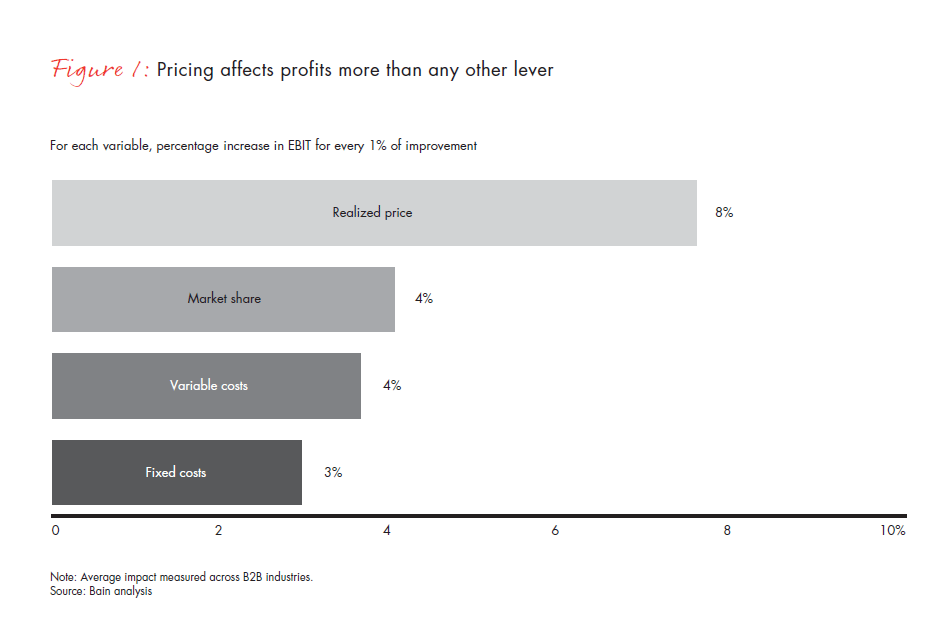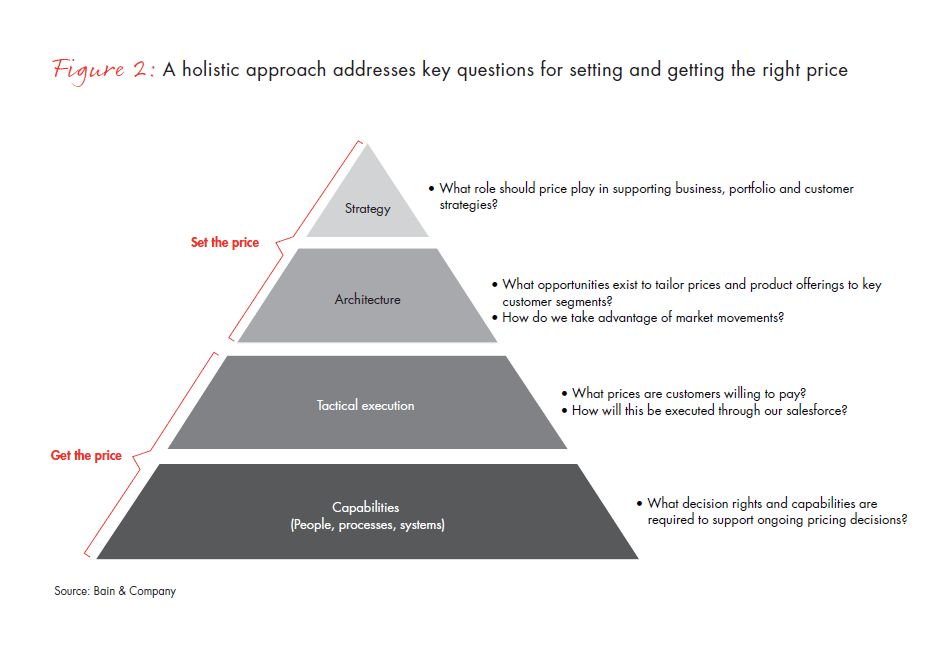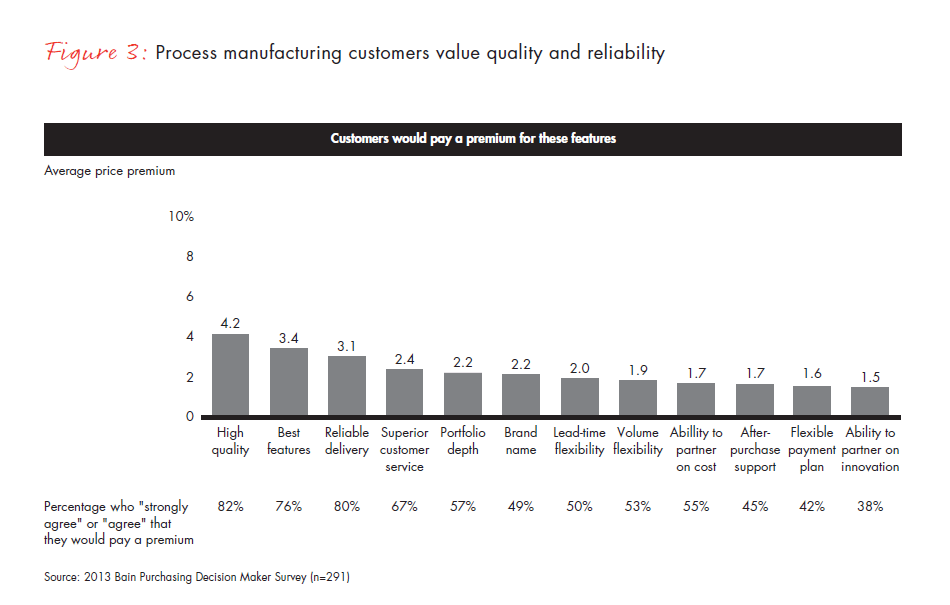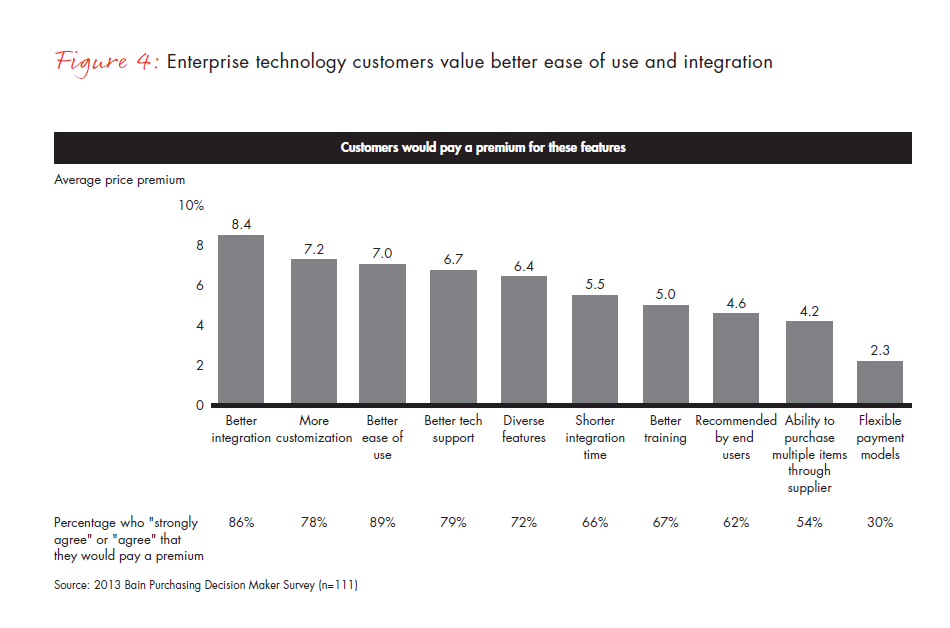Brief
When executives in business-to-business (B2B) markets think about pricing their products, they often raise the white flag before even stepping onto the battlefield. Over the years, they’ve accumulated beliefs that limit their pricing effectiveness.
Five beliefs, in particular, have become ingrained in many companies to the point that they seem immovable:
- Our products are commoditized, so we must accept prevailing prices in the market.
- We can’t respond effectively against new, disruptive business models—much less figure out if we should be the disruptor—without jeopardizing our core business.
- We can’t constrain negotiations without killing the ability of our salesforce to close deals.
- We need to maintain legacy channel discounts to motivate our partners, even though those discounts create complexity and obscure our view of profitability.
- It doesn’t matter if our list prices are competitive, because we hit the right price points through heavy, nonstandard discounts.
Fortunately, the experiences of leading companies in markets ranging from chemicals to technology to precision instruments point to several ways to break out of these self-imposed shackles. B2B companies usually have far more pricing flexibility than they realize.

Clearing the roadblocks to better B2B pricing
When it comes to pricing their products, B2B companies are aren't as trapped as they often think they are.
Recognizing that one does, in fact, have pricing flexibility opens huge opportunities for improving profitable growth. Many B2B executives understand that pricing has a more powerful impact on the bottom line than other means such as gaining market share or reducing costs. Bain & Company analysis of dozens of B2B companies across a wide range of sectors shows that companies earn an 8% increase in operating profit for every 1% of improvement in realized price; that’s roughly twice the benefit as a 1% improvement in market share, variable costs or fixed-cost utilization (see Figure 1).
Yet while companies dedicate ample resources to continually reduce costs or sell greater volumes, they rarely invest to the same extent in their pricing capabilities. As a result, they leave money on the table and leave the door open for competitors that understand the power of effective pricing.

Pricing has long been challenging for B2B companies. Products reach end customers through a direct salesforce as well as indirect distributors, such as resellers, which makes for a complex and sometimes turbulent go-to-market environment. Prices often are negotiated based on many factors, rather than taken at list price. The negotiations, moreover, give salespeople a good deal of power to set the final price. And commission structures often motivate salespeople to close the deal at a low price rather than push for the profit-maximizing price. Channel partners have access to a wide range of program and promotional discounts, and often they can game the system at the supplier’s expense. Achieving more effective pricing requires good data and insights, but these tend to be scattered across different functions, with the lines of communication often poor or nonexistent.
What’s more, recent developments have sparked greater urgency for companies to get pricing right. Purchasing departments have become more aggressive and sophisticated, and in many cases are expanding the spending categories they manage. Also, it’s relatively easy for buyers to get price information through an Internet search, which can knock out a supplier from consideration before it has the chance to start conversations with potential customers. Innovative digital competitors, meanwhile, are disrupting traditional pricing norms.
In this more fluid environment, companies are hard-pressed to capture the full value of their products and services. Doing so requires a holistic approach that accounts for external factors, such as the behavior of customers and competitors, as well as internal factors, such as costs, processes and IT systems. The approach should cover the two main areas of pricing (see Figure 2):
- Price setting. Structuring and defining the target price waterfall for each product or service—that is, determining the list, net and final prices the company wants to realize, as well as the types of discounts it will use to achieve those price points.
- Price getting. Ensuring effective discounting on a deal-by-deal basis to achieve the target waterfall.

The five limiting beliefs that pervade many B2B organizations stand in the way of systematic improvement in both areas. But leading companies have addressed the five beliefs head-on and have managed to overcome them through deliberate efforts to redesign pricing approaches and sales practices.
1. Our products are commoditized, so we must accept prevailing prices in the market.
Many companies pigeonhole themselves as price takers, believing higher prices or a tougher stance on pricing will cause customers to defect. This is the single most pervasive, self-destructive belief about pricing we encounter. It’s most common when a product or key input trades on public markets as a raw commodity, or when executives believe there’s no opportunity to capture a premium for the added value they provide. Salespeople perpetuate this belief when they frame conversations with customers around price, because they don’t know enough about the benefits or differentiated aspects of their offering.
In most cases, price takers overlook a range of other factors that customers care about and that justify a price premium. These factors include reliable and flexible delivery, a willingness to hold inventory and consultative advice about the timing of purchases.
Consider the evidence from a recent Bain survey of more than 400 purchasing executives for two major categories of corporate spending: bulk raw materials (such as metals, chemicals, agricultural commodities and paper goods) and enterprise hardware, software and services. The survey asked executives about the role of price in their purchases relative to other elements of the overall proposition.
Even in bulk raw material categories commonly thought to be pure commodities, price is rarely the most important decision criterion. It trails reliable delivery, reliable supply and quality when respondents are selecting a supplier. In fact, customers will pay a 4.2% premium for higher quality and a 3.1% premium for more reliable product delivery (see Figure 3). Moreover, 88% of customers would pay at least 2.5% more for a product—and some customers much more—to avoid switching suppliers.

In computer hardware, software and services, price is again not the most important factor. Survey respondents are willing to pay 8.4% more for better integration with other technical systems, 7.2% more for the ability to customize the product and 7.0% more for ease of use (see Figure 4).
To be sure, there are industries and businesses where most of the product volume cannot be priced higher than the going market price. But even in these industries, pockets of customers and SKUs exist that are less exposed to cost pressure and thus less price sensitive. For such groups, it’s feasible to make meaningful price increases without putting overall volume at risk.

Grains and oilseeds, for instance, trade on regional exchanges and would seem to be pure, undifferentiated commodities. But some buyers are more discriminating than others. End users, like packaged foods manufacturers, pay materially more for these commodities than do resellers, because they value suppliers that can reliably deliver consistent quality and provide insights into the underlying markets.
To tease out the features that potentially merit a price premium, a company can use surveys and past buying behavior. With these tools, it can segment its customer base according to differences in key purchasing criteria, which decision makers are involved and how many bids typically are requested. It can then quantify how differences in products and services create differences in each segment’s value. Where there are meaningful opportunities, these differences can be baked into a company’s pricing structure.
Case in point: Semiconductor makers cannot interrupt their manufacturing process midstream, or else they will lose an entire batch of chips, which is costly. Wafer fabrication plants thus tend to locate where they can buy consistent, reliable electrical power, and they’re willing to pay more to utilities that can provide it.
2. We can’t respond effectively against new, disruptive business models—much less figure out if we should be the disruptor—without jeopardizing our core business.
Customers’ priorities have shifted in two ways that have prompted some companies to adopt new, potentially disruptive business models. Many business customers only want to pay for actual results that a product delivers, rather than for potential results. In addition, more customers want to shift capital expenses to operating expenses, reducing the need for large, up-front investments. They’re demanding new price meters; for example, they want jet engines priced per mile or per hour flown, rather than per engine, or copiers priced per printed page, rather than per machine. This model allows them to pay for the value they receive, not for capacity they never use.
In parallel, more B2B companies are trying to use pricing mechanisms that give them a share of the value they create for customers. The difficulty for many B2B companies is that current per-output price meters often don’t reflect how customers want to buy today, the value companies provide to customers or the costs of providing the goods or services. Some companies give away too much value to the customer relative to their competitors. Others experience costs scaling up faster than prices, so they lose money on large deals or heavy users.
Many companies’ internal systems cannot support new meters that base price on customer usage rather than on capacity. Their long experience in one pricing structure turns out to be irrelevant for the new structure. Take the copier business. To implement a per-page pricing structure for a copier, a supplier must be able to measure how many pages are printed correctly, sense when a copier needs repair and send out a technician, and accurately factor a new range of risks and rewards into the price point. The supplier faces capital risk by continuing to own the copy machine but has the added reward of likely increasing customer retention over time. Implementing a new usage based price meter thus requires significant new capabilities for most companies.
The key is to evolve the product’s pricing model so it directly addresses a wider set of customers’ needs and priorities, rather than to focus on the product alone. Developing a deeper understanding of customers’ priorities will help determine whether the business and pricing models of disruptive competitors will likely be a niche or the new norm.
Based on that deep understanding, once the enabling infrastructure is in place to properly implement a new price meter, major changes can be executed swiftly, without customer hand-holding, if a company has sufficient market power and authority. Google did this with its App Engine platform for software developers, and so did Adobe when it moved from selling software in a box to all subscription-based pricing. Many of the major mobile phone carriers moved quickly when they shifted from unlimited data pricing to models with tiered usage-based pricing. Each was determined to make its pricing reflect the real costs and risks it was incurring by moving to a new business model or by accommodating power users that had been getting a subsidized ride.
Many business-to-business (B2B) companies view their products as commodities and assume that they must accept what the market wants to pay. However, companies that differentiate themselves through strong service, reliability and flexibility can often charge premium prices that customers will be willing to spend, says Stephen Mewborn, a partner in Bain's Customer Strategy & Marketing practice.
3. We can’t constrain negotiations without killing the ability of our salesforce to close deals.
When the sales team has a broad mandate without clear discipline, profits leak out of the enterprise. Sales needs some flexibility to negotiate, but the typical approach companies take undercuts effective pricing in several ways.
In many industries, sales incentives emphasize bookings, not profit margin. That motivates sales representatives to give away too much on price simply to close the deal, without considering the economic value of the final deal. To complicate matters, individual reps often negotiate different discounts for the same product, and the companies have no standardized procedures to assess the appropriateness of a proposed discount. As requests mount for approval of discounts, sales managers become overwhelmed and approve virtually everything, leading to a massive and unintended reduction in net prices. Help salespeople help themselves. Equip the salesforce with business intelligence to make smarter pricing decisions, and install a clear, fast process for decisions that need approval.
The salesforce should be armed with statistically based guidance on how to price deals, factoring in deal characteristics that emerge as bids are developed. Commissions, bonuses and other forms of compensation should be redesigned to promote discounting that benefits the company’s long-term economics, not short-term volume gains. A company may be better off if every sales rep discounts less, because on balance most deals will still close, with better economics. But the unlucky rep who loses a key account because of a firmer stance on discounts might face a low bonus year or worse. Compensation structures thus need to account for this inherent mismatch between the risk profile of the individual rep and the company. Hiring and job promotion practices should be modified as well, so that job security and performance evaluation don’t hinge solely on how much volume a rep generates.
Disciplined discounting comes easier for companies when they create standardized criteria and a process for scoring and approving discount requests based on a deep understanding of customer lifetime value, rather than quarterly quotas or promises of strategically important deals. Leading companies also insist that approvals be made in days, not bottled up for weeks, and they track the performance of all levels of the approval chain through monthly scorecards. These steps help make the process transparent and encourage a culture of rigorous discount management.
One asset leasing company, for instance, was plagued by an “every deal is unique” mentality, which depended on the market, the time of year, asset characteristics and the nature of the customer. This variability made it difficult for management to influence pricing decisions, and an assessment showed that pricing leakage was common. By building simple deal-pricing tools and establishing rules based on an escalating system of approvals, the company was able to bring order to the pricing of most standard deals. That elevated the truly unique, important deals to senior executives so they could make the final decision based on a broader strategic perspective.
4. We need to maintain legacy channel discounts to motivate our partners, even though those discounts create complexity and obscure our view of profitability.
Discount programs for wholesalers and other distribution channel partners serve a critical role in motivating them. But such programs can be managed far more effectively.
When discount programs and promotions proliferate, suppliers lose control. Various discounts—volume, minimum level of spending, new account, product and geography- specific, and front-end and back-end—might each make sense in isolation. In aggregate, though, they sometimes allow partners and customers to qualify for a price that’s below cost. As these discounts stack up, it becomes hard for executives to know whether a particular deal will be profitable and channel partners can double-dip, getting multiple discounts from different people for the same behavior. This complexity also makes it difficult for channel partners and sales teams to effectively communicate the right price points.
To counteract this complexity, it pays to redesign or refresh on a regular basis the portfolio of discounts, focusing on a small number of important incentives with meaningful benefits. The portfolio ideally has the following traits:
- A finite number of major incentives for channel partners.
- A simple, clear set of programs and promotions that are aligned to incentives. Companies should remove obsolete discounts and focus on those with the highest return on investment. At the same time, they should ensure enough consistency over the long run to allow channel partners to invest in capabilities needed to qualify for the programs.
- Performance-related discounts balancing revenue growth and margins. If a channel partner hunts new customers who meet the right parameters, it receives a particular discount. That’s more effective than demographic discounts that reward partners for finding customers above a certain size or in a high-growth industry.
This approach worked for one US-based technology company that had lost control of its channel-discount portfolio. Different units had created different incentives for channel partners, which had meant that these partners sold whatever they could, then used the supplier’s staff to comb through programs to see what partners could qualify for after the fact. A complete redesign of the portfolio cut 70% of the programs and focuses on a small number of high-impact incentives. The result: a simpler portfolio that provides the same net prices but makes it easier for the technology company and its channel partners to do business, and also makes plain where discounts are going and why.
5. It doesn’t matter if our list prices aren’t competitive, because we hit the right price points through heavy, nonstandard discounts.
In most B2B settings, customers often conduct an initial supplier screen that factors list price into the mix. If a supplier’s pricing strategy consists of high list prices and high discounts, and that runs counter to the norm for a particular market, the company will get knocked out of consideration early.
List price can become toothless for other reasons as well. The price might not be adjusted for exchange rates or differences in products’ regional competitiveness. New products might be priced according to the pricing strategy of old products. Contracts and internal processes might be too rigid to respond quickly to changing market conditions, to adjust for a product’s life cycle or to integrate the pricing models of acquired companies. The latter is a vexing problem, because list prices and discount spreads for the acquired firm may be quite different than the acquirer’s, but are set in place through long-term contracts.
Despite all of these challenges, list prices serve as an anchor that must correspond to the customer’s view of reality. Once a company moves its list price into the appropriate range, what matters most is to rigorously assess whether the net price will yield a tolerable profit margin.
Developing a pricing playbook will ensure that prices are set based on the product’s economic value to customers and its life stage. Alongside that playbook, a company should put in place a process for regularly checking foreign exchange and competitors’ price moves, so that list prices stay locally competitive.
For companies that make acquisitions or have a range of products with different pricing dynamics, it’s valuable to create a menu of pricing options that acquired companies can choose from to hit the right list and net price points. The menu should provide enough flexibility to allow products to be competitive, but should also limit options to minimize complexity.
All hands on deck
Pricing is an inherently cross-functional discipline. Yet it’s rare for a single senior executive or small executive team to be charged with owning the pricing framework across the enterprise. Typically, no one owns the logic of what the company is trying to do with price, the critical capabilities that need to be developed or the logic governing discounting approvals.
Lack of accountability leads to a proliferation of options and workarounds, as well as inefficient hand-offs between departments for key decisions, such as pricing an advanced new product or determining when plant capacity use is high enough or low enough to prompt a price change.
Vague processes for determining the value of a deal or partnership also result in lost opportunities and even unprofitable commitments. One technology firm was asked by a major customer to offer teleconferencing services based on usage. The sales team quickly agreed before consulting other departments, such as IT, operations and accounting. It turned out the internal systems were not equipped to handle the new venture. That firm now deploys literally hundreds of employees to collect data for billing and to sort out taxes associated with usage in different countries.
Pricing is important enough to warrant a true owner who can provide a company-wide perspective on pricing trade-offs, even if the final decision rests with product and market leads. The practical challenges demand an executive who can assemble the pieces strewn throughout the organization into a coherent whole, which includes the active collaboration of functions outside of product, sales and marketing. That’s what it takes to break free from the shackles and regain the pricing flexibility required for profitable growth.
Easy pricing tactics for quick gains
Besides redesigning your pricing approach for the long term, you can also take advantage of tactical actions that don’t require new capabilities or customer insights:
- Some customers may not be meeting contractual obligations for volume discounts. Reprice them for the actual volume they purchase.
- Look for record-keeping or accounting errors that are causing you to undercharge.
- If you charge a premium for value-added services, such as rush or special orders, there may be customers that use the services without consistently being charged. Make sure they pay for the services received.
- Identify customers that are not being served by the factory or distribution center with the most advantageous location from a profitability standpoint. Switch them to the best location.
- Comb through SKUs to identify those that serve exactly the same function or meet the same need, yet are priced differently. Either increase the price of the cheaper SKU or discontinue it.
Stephen Mewborn is a Chicago-based partner in Bain & Company’s Customer Strategy & Marketing practice. Justin Murphy is a San Francisco-based partner in Bain’s Customer Strategy & Marketing and Technology, Media and Telecommunications practices. Glen Williams is a London-based partner in Bain’s Customer Strategy & Marketing practice.



